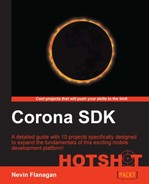If you're a long-time or low-level programmer, you may be accustomed to controlling the core of your game loop; if you're more used to recent game engines, you may have learned to juggle complex information about what actors in your game are doing at any given moment. In Corona, the combination of a separately-tracked physics engine and the versatility of Lua will, when used correctly, manage this information for you.
We'll explore this idea of managing progress through a game schedule by completing a scrolling shooter in the tradition of games such as Xevious or River Run, where the player maneuvers a ship around the screen, avoiding enemy fire and destroying enemy ships until he/she reaches a boss target. Enemies will include ships that fly various patterns across the screen, turrets that follow the scrolling background and turn to face the player's ship, and a boss at the end that takes many hits to destroy and moves in various directions, firing multiple weapons. The player's ship will be able to fire at points on the screen that the player touches.
The player maneuvers their ship around the screen as the ground scrolls under them from the top of the screen downward. As the scrolling background reaches certain points, enemies appear and fly or scroll around the screen, firing bullets as they go; the player must avoid the bullets as well as the ship itself while shooting back.
Like the Deep Black game, this project will be based on Corona's Box2D-based physics library. In this version, most objects will be "sensors", meaning they only detect collisions, and do not bounce off of each other or transfer momentum. We'll also use Box2D's collision filters so that we don't need to process enemy ships colliding with each other, or bullets hitting each other.
In the TranslationBuddy project, we got a taste of coroutines and how they can be used to bookmark a task that you're in the middle of and come back to it later. In this project, we'll take that concept much further, using coroutines to create scripted behavior that's carried out over time, which is the simplest part of what game players and developers usually refer to as AI. We'll create computer-controlled fighters that follow flight assignments which are predictable at run time, but easily customized by the designer.
In addition to coroutines, we'll also use a Lua feature called environments to create a minimal language of very simple functions controlling intervals and enemy actions. Features like this can become useful in larger projects, where programmers and designers must collaborate on a project. In such projects, programmers are responsible for the code that carries out the actions which the enemies will take, but the decisions of what the enemies should do, when, and in what order, are made by game designers, and frequently have to be adjusted for best balance and fun. For this reason, it's good to let the designers edit these schedules and scripts themselves. Designers are usually not experienced programmers, although they often have a little knowledge of programming and scripting, so this simple language will make it much easier for the designers.
For this project, we'll review the design, rather than creating it. While an indie programmer will often be designing their own games and then coding from their designs, any programmer at a studio is likely to be coding from a document given to them by a designer or design team. We will be managing game progress with the help of the following game coroutines:
- Founding the framework
- Moving the player
- Scheduling enemies
- Scripting behavior
- Controlling the boss
- Cleaning up and making the game playable
First, open the file design.txt from the project pack and read through it, noting the [NYI] tags that indicate features still pending. In full development projects, this sort of status tracking will usually be carried out by a more complex database or dedicated tracking program, but even in small projects, a simple record of what has yet to be accomplished can be very useful.
At this point, the game has files describing various ships (a broad category which also includes the ground-based, immobile turrets) as well as the various weapons with which the ships are equipped, the bullets they fire, and the explosions when they land. It also includes code that handles things taking damage—including events that can be tracked by user interface elements or gameplay progress tracking, processing user input into commands, and a long background made up of large tiles. A splash screen is already completed and appears when the game is launched.
What the game still needs is actual level design. Enemies need to appear as time advances in the level, and carry out various plans of attack against the player. This means that there are two kinds of schedules required; the schedule of which enemies appear when, and the individual schedules of the enemies that dictate how each one flies and attacks after it is created. To make this happen, we'll not only create scheduling behaviors, but also modules that attach these behaviors and other suitable characteristics, such as orientation, to our predefined ships to make them into bosses and enemies.
Once that's done, create a new project folder, Atmosfall, and copy the contents of the version 0 folder in the project pack directory. You should be able to load this project into the simulator and advance the game past the splash screen, seeing a ship in the middle of a swamp background. In the simulator, you can click anywhere on the game screen and watch the ship fire double bullets at the point at which you click. You can also build the game for a device and watch the ship slide around the screen as you tilt the device. The prototype responds to user input and is ready to start adding the scheduling and AI enemy control.
